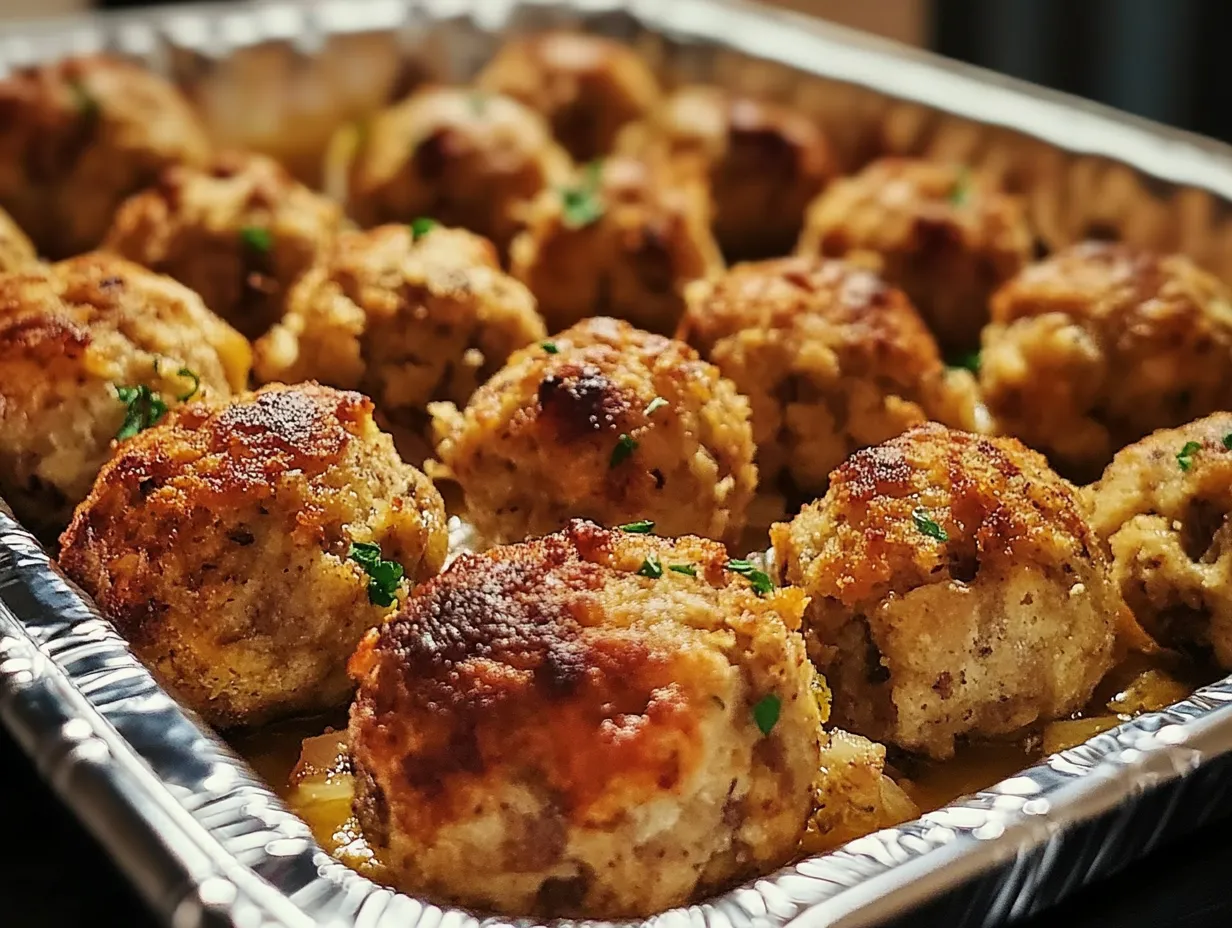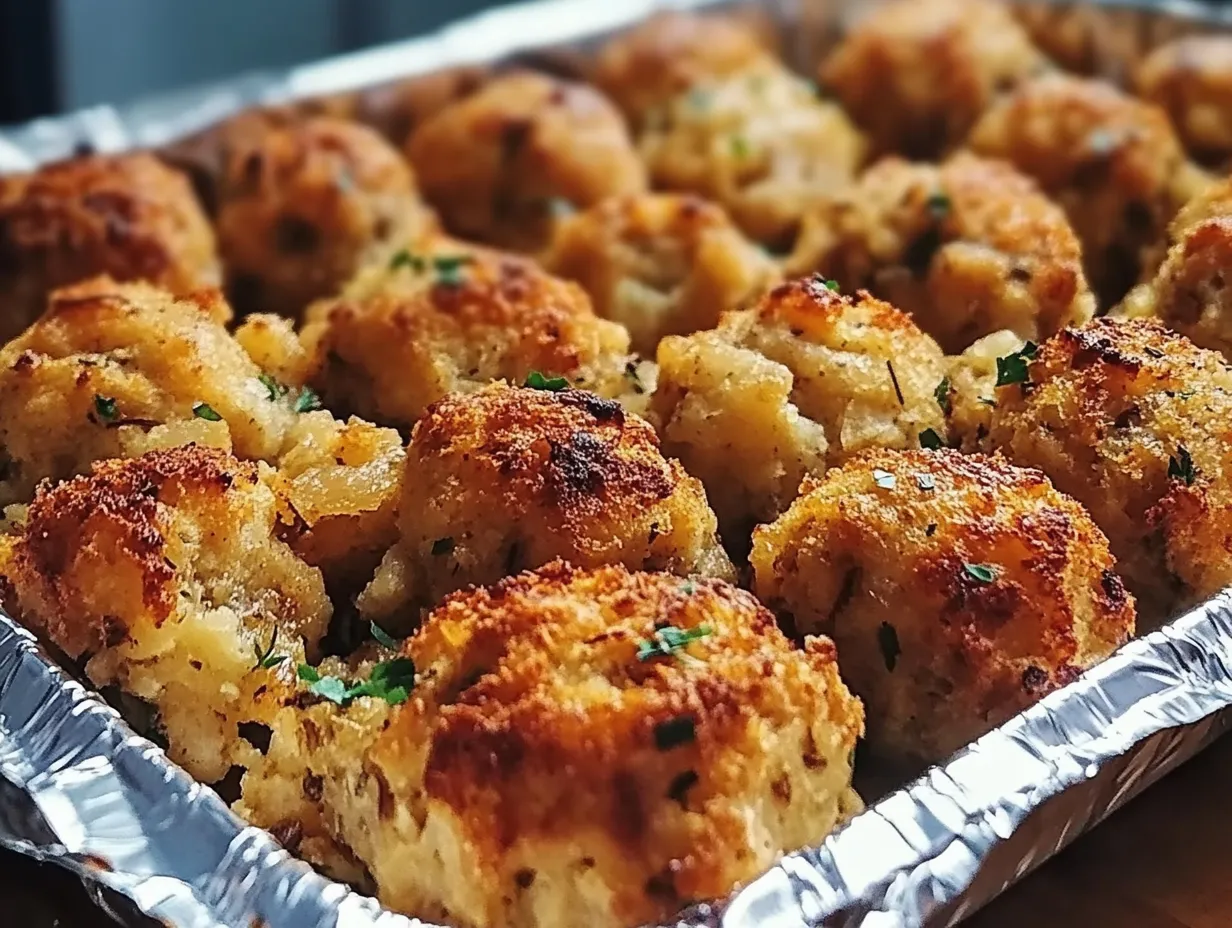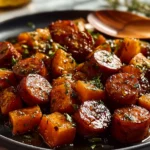Stuffing balls offer a delightful twist on classic stuffing, transforming the beloved holiday side dish into convenient, bite-sized servings. Unlike traditional stuffing, which is typically baked in a large dish or even inside a turkey, stuffing balls are individually portioned, making them easier to serve and enjoy. This unique presentation adds an element of fun and visual appeal to the holiday table, enticing guests with a playful take on familiar flavors.
These compact, golden-brown bites are perfect for Thanksgiving, Christmas, and other festive gatherings, quickly becoming a crowd favorite. Not only do they embody the comforting flavors of onion, celery, and savory seasonings, but they also solve a common holiday dilemma: portion control. By serving stuffing in ball form, everyone can enjoy just the right amount without needing to cut or scoop, which keeps the presentation neat and minimizes waste.
Additionally, stuffing balls are highly versatile, accommodating various dietary preferences with simple adjustments. Whether served as an appetizer, side dish, or snack, stuffing balls bring a touch of convenience and creativity to holiday meals, capturing the cozy essence of traditional stuffing in a new, appealing form.
Ingredients Overview and Their Importance
Dry Stuffing Mix
The base of stuffing balls, dry stuffing mix, comes in various types that can influence both the flavor and texture. Options range from seasoned mixes, which may include herbs and spices, to unseasoned varieties that allow for more customization. Bread types, like cornbread, sourdough, or whole wheat, also affect the final dish. Cornbread offers a slightly sweet, crumbly texture, while sourdough gives a chewy bite with a hint of tang. Choosing a mix tailored to your flavor preference is key to creating a stuffing ball with the right taste and consistency.
Chicken Broth
Chicken broth brings necessary moisture and rich flavor, ensuring the stuffing balls aren’t dry. As the bread absorbs the broth, it softens and gains depth, helping bind the ingredients together. For a vegetarian option, vegetable broth works well, though it provides a lighter taste. For extra richness, some home cooks might even use bone broth, which adds more body to the mixture.
Unsalted Butter
Butter lends richness and a melt-in-your-mouth texture to stuffing balls. By using unsalted butter, you can better control the overall salt level of the dish. The butter also helps bind the ingredients, adding a creamy quality that enhances the flavor. For a healthier or vegan version, olive oil or a plant-based butter alternative can be used, though it will slightly alter the taste.
Eggs
Eggs are essential for binding the stuffing balls, holding everything together while adding structure during baking. Without them, the balls might crumble. For those with dietary restrictions, flaxseed meal or chia seeds mixed with water can act as a vegan egg substitute, though the texture may be slightly less firm.
Onion and Celery
Onion and celery are the classic vegetables in stuffing, adding aromatic flavors and a bit of crunch. The sweet, savory taste of onion complements the herbaceous notes in the seasoning, while celery’s subtle bitterness balances the richness. Finely chopping both vegetables is important to ensure an even texture throughout the stuffing balls.
Poultry Seasoning
Poultry seasoning is a blend of herbs like sage, rosemary, and thyme that brings earthy, savory warmth to the stuffing. Its flavors echo traditional stuffing, enhancing the nostalgic taste. If unavailable, you can substitute it with a mix of dried sage, thyme, and rosemary, or adjust to personal preference by adding any of these herbs individually.
Salt, Pepper, and Fresh Parsley
A sprinkle of salt and pepper enhances the dish’s flavors without overpowering them. Fresh parsley adds a pop of color as a garnish and contributes a hint of freshness that balances the savory elements. These final touches ensure each stuffing ball is well-seasoned and visually appealing for serving.
Essential Equipment for Perfect Stuffing Balls
To make perfect stuffing balls, having the right equipment can streamline the process and ensure consistent results. Here are the essentials you’ll need:
Baking Sheet
A standard baking sheet is ideal for holding the stuffing balls as they bake, allowing for even heat distribution and a golden-brown exterior. If available, a heavy-duty baking sheet helps prevent any warping under high oven temperatures, ensuring reliable cooking.
Parchment Paper or Silicone Baking Mat
Lining the baking sheet with parchment paper prevents the stuffing balls from sticking, making for easy cleanup and hassle-free removal once they’re done. A reusable silicone baking mat is another excellent option, as it offers a non-stick surface and can be reused for future baking projects. Silicone mats also help distribute heat evenly, contributing to a consistent bake.
Large Mixing Bowl
A large mixing bowl is essential for combining all the ingredients without making a mess. It allows for thorough mixing, ensuring that the dry stuffing mix, broth, butter, and seasonings are evenly incorporated. This ensures every bite of the stuffing balls has balanced flavor and texture.
Additional Tools
Other useful items include a spoon or cookie scoop to portion out the mixture and help create uniform stuffing balls. If you want perfectly round balls, a small ice cream scoop or even a melon baller can be helpful.
Baking Tips
For the best results, leave a bit of space between each stuffing ball on the baking sheet to allow for even airflow, promoting an even bake. This setup helps ensure your stuffing balls come out perfectly golden-brown and firm.
Step-by-Step Recipe Instructions
Preheating and Baking Sheet Prep
Start by preheating your oven to 350°F (175°C). Preheating is crucial as it ensures the oven reaches the desired temperature before the stuffing balls go in, promoting an even bake. While the oven heats up, line a baking sheet with parchment paper or a silicone baking mat. This step prevents the stuffing balls from sticking and makes for easy cleanup afterward. If using parchment, ensure it’s trimmed to fit the pan without overhanging, as edges can burn.
Combining Ingredients
In a large mixing bowl, add 4 cups of dry stuffing mix, 1 cup of chicken broth, and ½ cup of melted unsalted butter. Stir until the mixture is evenly moistened, ensuring all dry pieces are softened by the broth. Add 2 beaten eggs, 1 small finely chopped onion, ½ cup finely chopped celery, 1 teaspoon of poultry seasoning, and salt and pepper to taste. Mix everything thoroughly until well combined. Take care to scrape the bottom of the bowl as you mix to make sure all ingredients are evenly distributed, creating a cohesive mixture for forming the stuffing balls.
Forming Stuffing Balls
Scoop a small handful of the mixture and gently press it into a ball, about the size of a golf ball. For consistent sizes, use a cookie scoop or spoon. Place each stuffing ball onto the prepared baking sheet, leaving about an inch of space between them. This spacing allows heat to circulate evenly, helping the balls cook consistently and achieve a uniform texture.
Baking Tips
Bake the stuffing balls in the preheated oven for 20-25 minutes, or until they’re golden brown and firm to the touch. Keep an eye on their color, as a deep golden hue signals they’re fully baked. To test doneness, lightly press a ball – it should feel firm without crumbling. Once baked, remove the tray from the oven and let the stuffing balls cool slightly before serving.
Serving Suggestions for Stuffing Balls
Stuffing balls are incredibly versatile and can be served in a variety of ways, making them a popular choice for holiday gatherings and festive meals. Their bite-sized shape and golden-brown appearance make them perfect for easy serving as an appetizer, allowing guests to enjoy a familiar flavor in a convenient, finger-food form. Arrange them on a holiday platter alongside other seasonal favorites like mini meatballs, roasted vegetables, and cheese selections for a festive appetizer spread.
As a side dish, stuffing balls pair wonderfully with main dishes such as roasted turkey, ham, or chicken. They allow guests to take individual portions without the need to scoop from a large stuffing dish, keeping the presentation neat and minimizing waste. Arrange them on a serving plate and garnish with fresh parsley for a pop of color.
For an enhanced flavor experience, consider pairing stuffing balls with traditional holiday condiments like warm gravy or cranberry sauce. Drizzling gravy over the top adds richness and moisture, while a side of tangy cranberry sauce provides a sweet contrast to the savory flavors. These accompaniments help round out the dish and make stuffing balls a memorable addition to any meal. Whether served alone or as part of a larger feast, stuffing balls add a cozy, festive touch to any occasion.
Storage and Make-Ahead Tips
Storing Leftovers
To store leftover stuffing balls, place them in an airtight container and keep them in the refrigerator. They’ll stay fresh for up to 3-4 days. When ready to eat, reheat the stuffing balls in a 350°F (175°C) oven for about 10 minutes, or until they’re warmed through. This method helps them retain their original texture better than microwaving, which can make them soggy.
Freezing Options
Stuffing balls can also be frozen for longer storage. After baking, allow them to cool completely, then arrange them on a baking sheet lined with parchment paper in a single layer. Place the baking sheet in the freezer until the balls are fully frozen (about 2-3 hours). Once frozen, transfer the stuffing balls to a freezer-safe container or zip-top bag, removing as much air as possible. They can be frozen for up to 2-3 months. To reheat, bake them from frozen at 350°F for 15-20 minutes or until heated through, maintaining their crisp texture.
Make-Ahead Prep
For busy holiday schedules, prepare the stuffing mixture a day in advance. Mix all the ingredients as directed, then cover and refrigerate the mixture in the bowl. When you’re ready to bake, simply form the stuffing balls, place them on a baking sheet, and bake as usual. This make-ahead option allows you to quickly assemble and bake the stuffing balls, saving time on the day of your gathering.
Creative Variations and Flavor Twists
Vegetarian/Vegan Version
For a vegan-friendly version, substitute chicken broth with vegetable broth, which provides a similar depth of flavor without animal products. Replace butter with a plant-based alternative, like vegan margarine or olive oil, to retain moisture and richness. For the eggs, use a flax or chia seed “egg” (1 tablespoon ground flaxseed or chia seeds mixed with 3 tablespoons of water per egg) to help bind the ingredients. This adaptation keeps the stuffing balls cohesive while ensuring they’re entirely plant-based and suitable for vegan guests.
Cheesy Stuffing Balls
Adding cheese to stuffing balls brings an extra layer of richness and a creamy texture. Mix in about ½ to 1 cup of shredded cheese, such as cheddar, Parmesan, or mozzarella, to the stuffing mixture before forming the balls. The cheese will melt as they bake, adding a gooey, savory element to each bite. This variation pairs especially well with a holiday feast, where the mild sharpness of cheese complements other rich dishes.
Spicy Version
For those who enjoy a bit of heat, incorporating spices like red pepper flakes, diced jalapeños, or even a dash of cayenne pepper can add a bold twist. Stir in ½ to 1 teaspoon of red pepper flakes or finely chop 1-2 fresh jalapeños and add them to the mixture for a spicy kick. This variation brings a lively flavor and is perfect for adding some excitement to the holiday table.
Herb Variations
For a more complex, aromatic flavor profile, experiment with fresh or dried herbs. Rosemary, thyme, and sage are excellent additions that elevate the traditional stuffing taste. Add about 1 teaspoon of each herb, finely chopped if fresh, or adjust to taste if using dried. These herbs not only enhance the flavor but also evoke the cozy, festive aroma of holiday dishes.
Add-ins
Create a festive twist by adding ingredients like nuts, dried fruits, or diced apples to the stuffing mixture. Chopped walnuts or pecans bring a delightful crunch, while dried cranberries or golden raisins add a pop of sweetness that balances the savory flavors. Alternatively, diced apples introduce a subtle tartness that complements the classic stuffing ingredients. Add ½ cup of any chosen add-in, stirring it in just before forming the balls, for a seasonal and unique flavor experience.
These creative variations allow you to tailor stuffing balls to suit different tastes, making them a versatile addition to any holiday meal.
Frequently Asked Questions
Can I use homemade stuffing instead of mix?
Yes, you can use homemade stuffing instead of a store-bought mix. Simply dry out your bread cubes before beginning, as a drier texture helps the balls hold together better. Homemade stuffing allows you to control the ingredients and customize flavors to your liking.
What can I use instead of poultry seasoning?
If you don’t have poultry seasoning, you can create a similar blend with dried herbs like sage, thyme, rosemary, and marjoram. A mix of ½ teaspoon each of sage and thyme, along with a pinch of rosemary, works well as a substitute. Adjust the amount based on your preference for a flavor boost.
Can these be made gluten-free?
Yes, stuffing balls can be made gluten-free by using a gluten-free stuffing mix or gluten-free bread cubes. Check that all other ingredients, like broth and seasonings, are also gluten-free to ensure the dish is safe for those with gluten sensitivities.
How do I keep stuffing balls from falling apart?
To keep the stuffing balls from falling apart, make sure the mixture is moist enough and that it’s well combined. The eggs and melted butter act as binders, helping the ingredients stick together. Pressing the mixture firmly when forming the balls also helps them hold their shape during baking.
How far in advance can I prepare the stuffing mixture?
You can prepare the stuffing mixture up to one day in advance. Cover and refrigerate the mixture, then form and bake the balls just before serving. This advance prep allows for quicker assembly on the day of your meal, saving time and ensuring fresh, warm stuffing balls.
Conclusion and Final Tips
Stuffing balls are a delightful way to enjoy the comforting flavors of traditional stuffing in an easy-to-serve, portioned form. For the best texture, ensure the mixture is moist and well-combined, and press firmly when forming the balls. Bake until golden brown for a satisfying crispness on the outside with a tender interior.
Don’t hesitate to explore different variations to suit your tastes—whether adding cheese for richness, a dash of spice, or festive add-ins like cranberries or nuts. Stuffing balls are versatile and customizable, making them a festive addition to any gathering. Enjoy!
Print
Stuffing Balls
- Author: Munil
Description
These stuffing balls are a fun, easy twist on traditional stuffing, perfect as a side dish for holiday meals or any comforting dinner. They’re flavorful, crispy on the outside, and soft on the inside!
Ingredients
- 4 cups dry stuffing mix
- 1 cup chicken broth
- ½ cup unsalted butter, melted
- 2 eggs, beaten
- 1 small onion, finely chopped
- ½ cup celery, finely chopped
- 1 tsp poultry seasoning
- Salt and pepper, to taste
- Fresh parsley, chopped (for garnish)
Instructions
1️⃣ Preheat Oven and Prepare Baking Sheet:
Preheat your oven to 350°F (175°C). Line a baking sheet with parchment paper to prevent sticking.
2️⃣ Combine Ingredients:
In a large mixing bowl, add the dry stuffing mix, chicken broth, and melted butter. Stir until the mixture is evenly moistened.
Add in the beaten eggs, chopped onion, celery, poultry seasoning, salt, and pepper. Mix everything until well combined.
3️⃣ Form Stuffing Balls:
Take a small handful of the mixture and shape it into a ball about the size of a golf ball. Place each ball on the prepared baking sheet, leaving a bit of space between them.
4️⃣ Bake:
Bake in the preheated oven for 20-25 minutes, or until the stuffing balls are golden brown and firm to the touch.
5️⃣ Serve:
Remove the stuffing balls from the oven and let them cool slightly. Garnish with fresh chopped parsley and serve warm.
Notes
- Make-Ahead Option: Prepare the stuffing balls and refrigerate them on the baking sheet for up to a day in advance, then bake just before serving.
- Serving Suggestions: These stuffing balls are delicious on their own, but they’re also great with a side of gravy or cranberry sauce!





